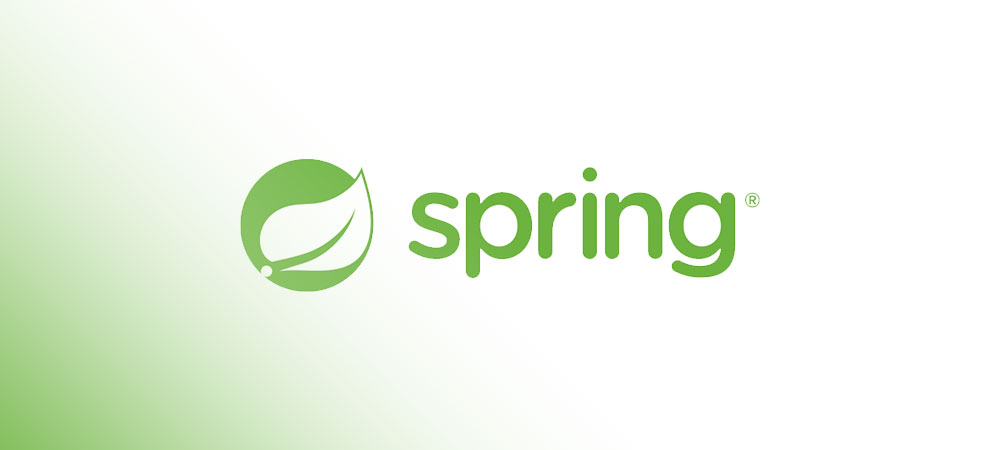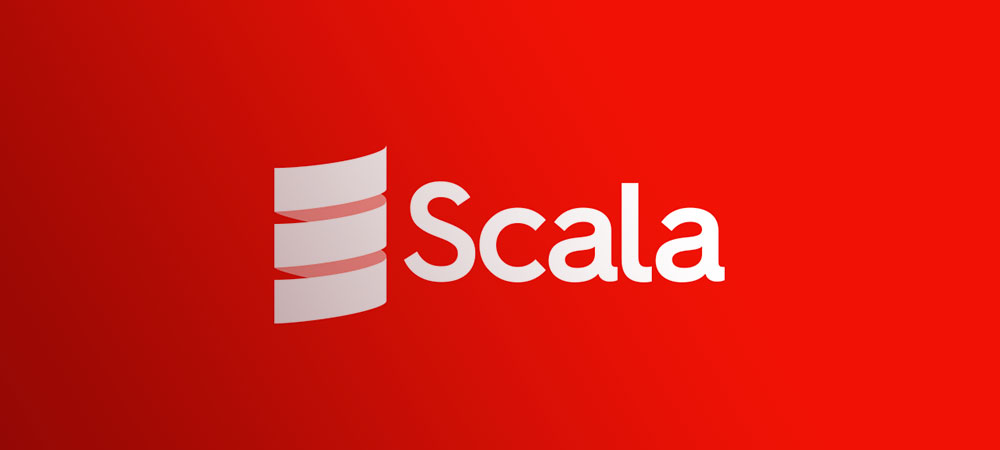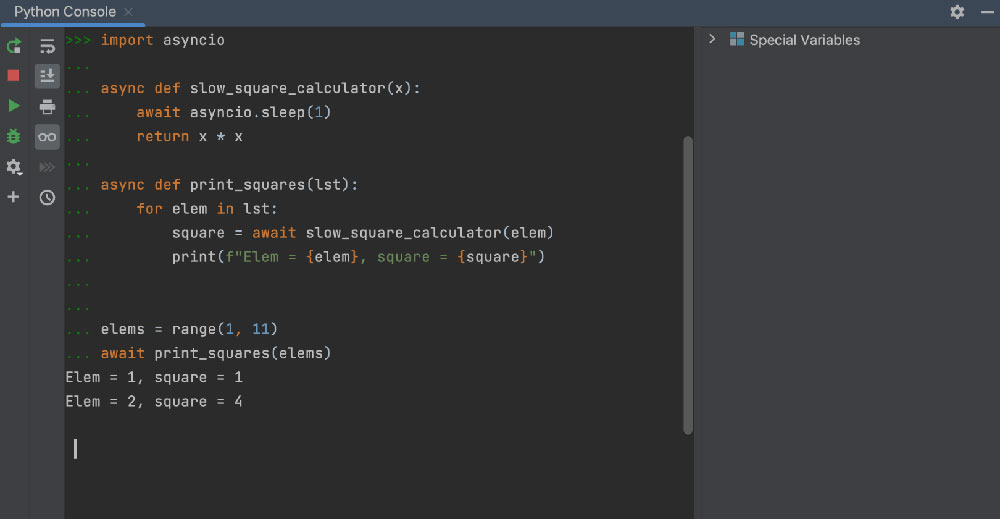Here’s the thing—when hammering out lines of code becomes as routine as your morning cup o’ joe, sometimes a little shake-up is what you need. A fresh perspective. That’s where diving into the world of Spring alternatives comes into play.
Let’s set the scene: Java’s like this massive playground, right? And Spring’s been the big kid on the slide for a long time, but that doesn’t mean it’s the only game in town.
There’s a treasure trove of frameworks out there—inversion of control, web apps dancing on the cloud, and lightning-quick servers ready to do your bidding.
We’re opening the door to lightweight frameworks and microservices that could flip the script on how you build applications.
By the tail-end of this chat, you’ll be clued in on tools that might just streamline your workflow or even give a jolt to your enterprise projects. Expect to see some slick names like Micronaut, Quarkus, or Vert.x slide through.
It’s not just about names though; we’re talking test-driven development, scalability, and all that jazz that makes your codebase solid as a rock.
Sit tight; we’re pushing the boundaries past that comfort zone, folks.
Spring alternatives
| Framework | Language | Programming Model | Key Features | Ideal Use Cases |
|---|---|---|---|---|
| Micronaut | Java, Kotlin, Groovy | Reactive, annotation-based | Fast startup, low memory footprint, AOT compilation | Microservices, serverless |
| Quarkus | Java, Kotlin | Imperative and reactive | Container-first, unified imperative/reactive programming | Cloud-native, Kubernetes-optimized |
| Vert.x | Java, JS, Groovy, Ruby, Ceylon, Kotlin, Scala | Event-driven, non-blocking | Polyglot, high scalability, reactive | Reactive applications, microservices |
| Ratpack | Java, Groovy | Event-driven, non-blocking | Lightweight, fast, built for async | High-performance web apps |
| Javalin | Java, Kotlin | Simple, lightweight | Easy to use, rapid development | Simple REST APIs, web apps |
| Spark | Java, Kotlin | Micro-framework | Simple, expressive syntax | Quick RESTful web services |
| Play | Java, Scala | MVC | Asynchronous, Scala support | Web applications, REST APIs |
| Lagom | Java, Scala | Reactive, microservices | Built-in microservices support, CQRS/ES | Reactive microservices |
| Helidon | Java | Micro-framework | Microprofile and SE implementations, GraalVM compatibility | Microservices, cloud-native apps |
| Ktor | Kotlin | Asynchronous | Kotlin-based, DSL for building web applications | Asynchronous web applications |
| Struts | Java | MVC | Classic, action-based framework | Legacy Java web applications |
| Vaadin | Java | Component-based, event-driven | Rich web UI components | Desktop-like web applications |
| Pippo | Java | Micro-framework | Lightweight, modular, template engines | Small to medium web applications |
| Ninja | Java | Full-stack | Convention over configuration, stateless | Rapid application development |
| Jooby | Java, Kotlin | Modular, scriptable | Microservices, multiprotocol | Modular Java backends |
| Armeria | Java | Asynchronous | HTTP/2, gRPC, Thrift, scalable | Microservices, asynchronous networks |
| JHipster | Java, Kotlin | Application generator | Generates boilerplate code, microservices, Angular/React | Bootstrap new projects quickly |
Micronaut

Micronaut zips through the dev world like a speedster. Picture this: a framework that’s making waves with its insanely quick startup times and minimal memory footprint. It’s like finding a sleek sports car that also happens to be super fuel-efficient. Made with microservices in mind, it’s all about creating apps that are nimble, cloud-friendly, and ready for the future.
Best Features
- Lightning-fast startup
- Low memory consumption
- Easy cloud integration
What we like about it:
There’s buzz around its ahead-of-time (AOT) compilation. Code shoots from your fingertips to a running app with hardly a hiccup in between. It’s like your ideas get fast-tracked to reality.
Quarkus

Quarkus is the new kid on the block that’s turning heads. It’s built to make Java perfectly suited for containers and microservices, which is like ensuring your concert is just right for the VIPs—the cloud-native crowd. This opens a door to a world where your hefty enterprise apps don’t have to feel so, well, enterprise-y.
Best Features
- Tailored for Kubernetes
- Unified configuration system
- Imperative and reactive coding
What we like about it:
Subatomic particle-sized services; we’re talking about booting up in the blink of an eye and running on the dimes of memory.
Vert.x
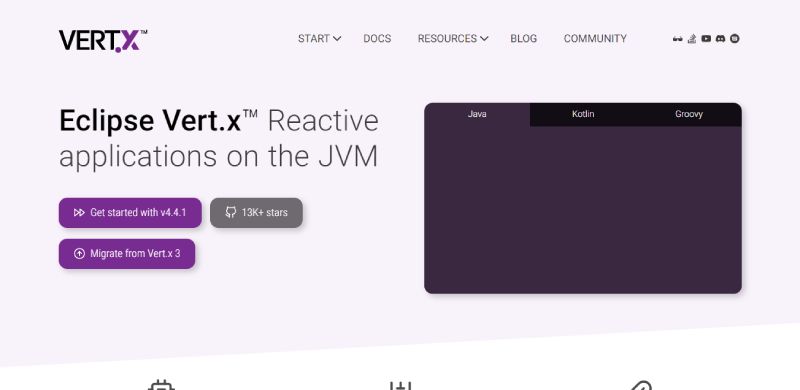
Vert.x brings a new rhythm to the Java scene. It’s not strictly a framework—it’s more like a toolkit, letting you craft reactive apps on the JVM with an artful blend of simplicity and flexibility. And it’s not riding solo, it supports multiple languages so you can groove in whatever language you fancy.
Best Features
- Polyglot language support
- Event-driven architecture
- Scalable and lightweight
What we like about it:
The event loop. It’s like the heart of a festival, pumping beats that keep the vibe flowy and asynchronous.
Ratpack
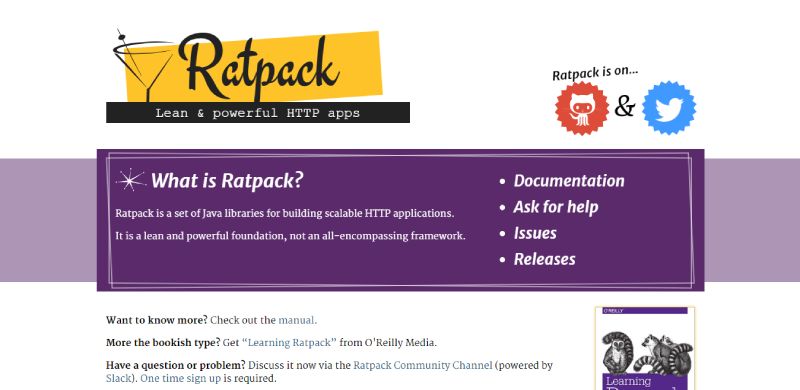
Ratpack’s the lean, mean serving machine that cuts through the web development noise. It’s got this simple, no-frills vibe that lets you build slick web services without getting tangled in complexity. And it’s not just about being lightweight; it’s about serving stuff up with speed.
Best Features
- Minimalist design
- Powerful and flexible under the hood
- Non-blocking, fast performance
What we like about it:
The unfussy approach. It’s like skimming the fat off your meal; pure taste, no heaviness.
Javalin
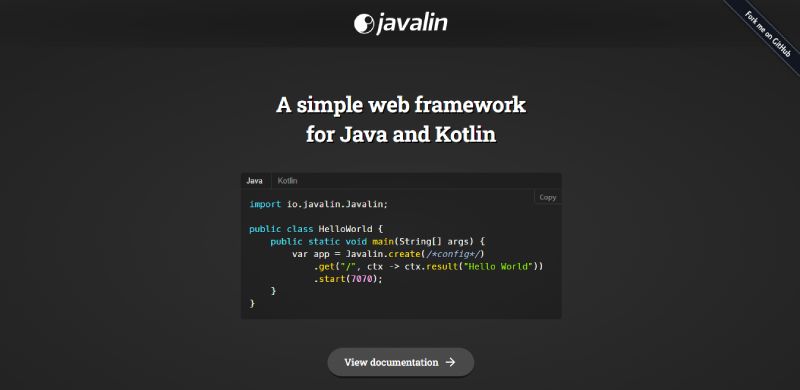
Javalin is Java’s straightforward handshake with simplicity. No massive learning curve, no ceremony, just you and a straight road to setting up web services. It prides itself on its minimal approach, making it a cool option for the quick and dirty coding session.
Best Features
- Super simple
- WebSockets and async support
- Lightweight
What we like about it:
The simplicity. It’s like talking without the need for fancy metaphors.
Spark
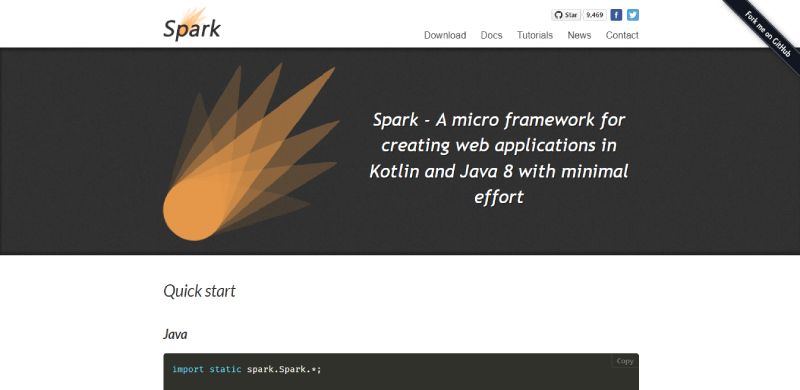
Not the big data Spark—this one’s all about lighting up your web apps with minimal fuss. Spark framework’s claim to fame is its micro framework size and its immense ease of use that’s perfect for whipping up a quick REST API or a tiny web app. It’s like the espresso of Java web frameworks—small, but packs a punch.
Best Features
- Immediate productivity
- Straightforward routing syntax
- Great for small services
What we like about it:
Instant REST APIs. It’s like microwave magic for web services.
Play
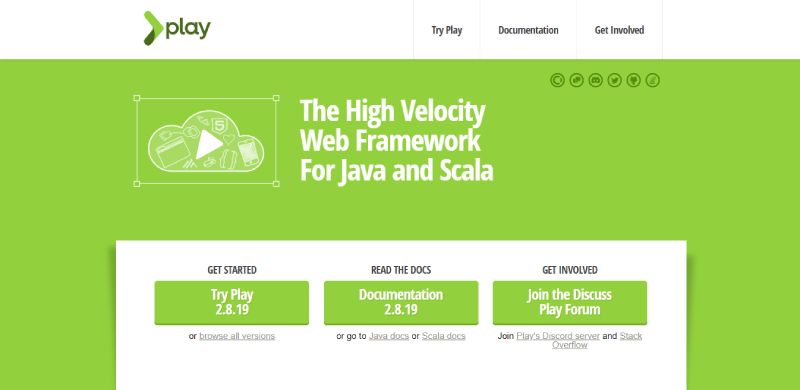
Play’s the theatre where your reactive applications and microservices get to star in their own show. Born to entertain with features like hot code reloading and a Scala-friendly environment, this guy goes hand in hand with developers looking for high-velocity performance without the drama.
Best Features
- Hot code reloading
- Asynchronous everywhere
- Integrated with Akka
What we like about it:
The hot reloading. It’s like being able to change the tires on your car while speeding down the freeway.
Lagom

Lagom steps onto the Java stage with a cheerful wave, promising to make building microservices less daunting. Its mantra is all about “just right” — not too little, not too much — and that’s a harmony developers often seek. The framework is all about the balance between productivity and magic.
Best Features
- Service isolation
- Event sourcing and CQRS patterns
- Seamless integration with Lightbend Reactive Platform
What we like about it:
The balanced approach. It’s all about making sense of microservices without a migraine.
Helidon

Helidon floats in like a lightweight raft you can steer through Java waters, especially if you’re navigating the microservices currents. It comes in two flavors: Helidon SE, which is the super slim version, and Helidon MP, which lines up more with the MicroProfile specs. It’s like having a dish that’s great whether you choose vegan or gourmet.
Best Features
- Two editions (SE and MP)
- MicroProfile APIs
- Transparent, no magic
What we like about it:
The no-magic part. What you code is what you get, no hidden surprises.
Ktor
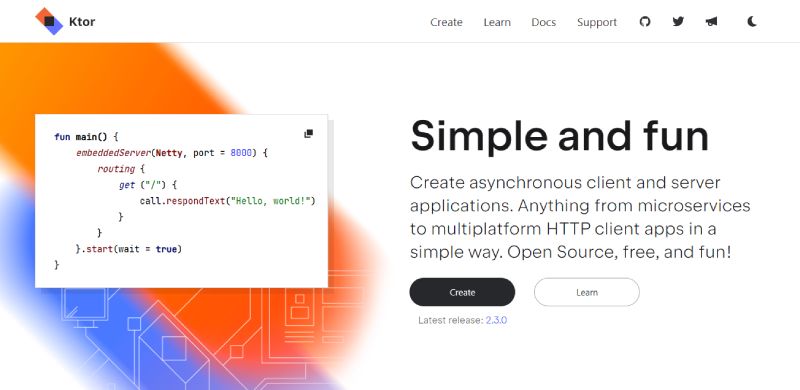
Ktor slides into your toolkit as the cool, coroutine-powered framework for Kotlin lovers. And yeah, the K stands for Kotlin. It’s straight out of JetBrains’ labs, which already tells you it’s gonna be tight and polished. Writing asynchronous servers and clients gets as comfy as your favorite bean bag.
Best Features
- Elegant Kotlin DSL
- Fully asynchronous
- Easy to test and maintain
What we like about it:
Coroutines. It’s like having ninjas handling all the complicated stuff silently in the background.
Struts
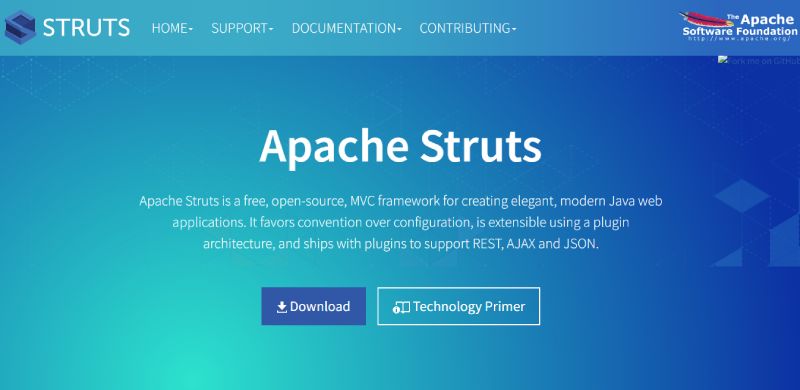
Struts once ruled the Java kingdom, and while it’s an elder among frameworks now, it’s got a legacy you can’t ignore. It’s a bonafide classic for building web applications with a front-controller pattern. It’s been through the wars, seen it all, and still it stands—just make sure you’re up for handling its vintage charm.
Best Features
- Extensive plugins
- Robust tag libraries
- Established community
What we like about it:
The kingpin status. There’s something to be said for experience and undying presence.
Vaadin

Vaadin waltzes in with a bag full of rich web components ideal for knocking out complex web applications. It’s quite the artist, designing web UIs on the server-side, abstracting away all the browser fuss, letting you paint your front-end in pure Java.
Best Features
- Component-based
- Server-side architecture
- Strong focus on UX
What we like about it:
The user experience it delivers. It’s like a butler for the web, offering users silver platter service.
Pippo
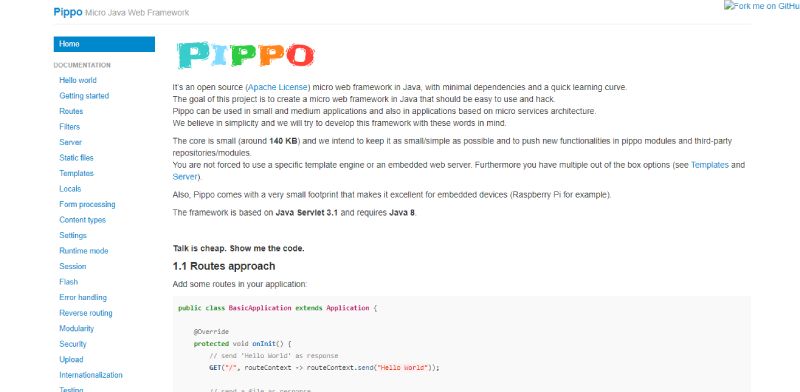
Pippo might be a lil’ pup in the frame pack, but don’t overlook it. It’s got an Express.js vibe going on, making it sweet for crafting applications swiftly. If you’re after micro or nano services, Pippo could be your unplanned yet delightful coding buddy.
Best Features
- Small and unassuming
- Modular and extensible
- Fast performance
What we like about it:
Snap in plugins and middlewares as easily as Legos. It’s handy like a Swiss knife.
Ninja
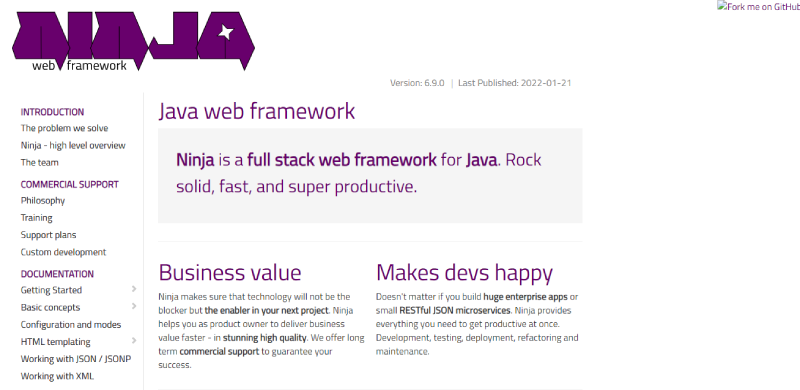
Ninja sneaks into Java territory with a full-stack shinobi outfit. It’s all about convention over configuration, so if you like a clear path to follow for building your web app, this one’s your sensei. It’s geared for modern web development and doesn’t like to make a lot of noise about it.
Best Features
- Convention over configuration
- Stateless architecture
- Strong focus on rapid development
What we like about it:
The silent productivity. It’s like coding with stealth mode on.
Jooby
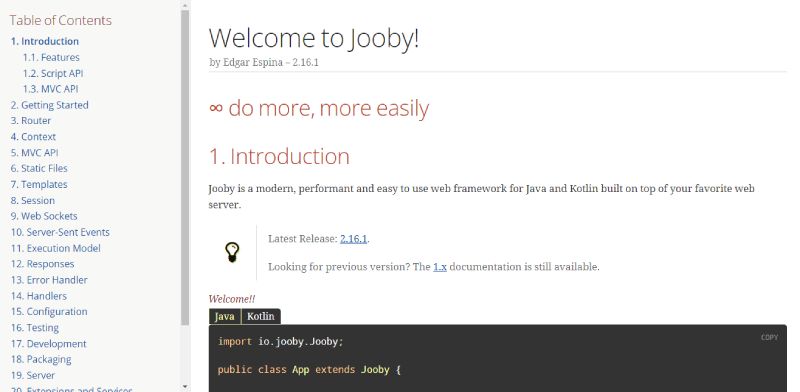
Jooby’s the scrappy underdog the Java world loves to root for. It packs microservices and modular apps into its lightweight ring, ready to rumble with asynchronous results. If you’re eyeing high throughput with low latency, Jooby enters as your contender.
Best Features
- Modular apps ready
- Asynchronous results
- Supports multiple servers
What we like about it:
Speed. It’s all about keeping things moving Quickly. No time for dawdling.
Armeria

Armeria tiptoes in with a sleek melody of asynchronous I/O and super-duper RPC. While it might not be the loudest in the room, it’s certainly a noteworthy framework for when you want your services speaking multiple protocols, all while doing the async dance beautifully.
Best Features
- Built-in documentation service
- gRPC and Thrift support
- JSON, binary, and text wire formats
What we like about it:
Agility with formats. It’s like a polyglot at the UN, speaking everyone’s language flawlessly.
JHipster

Last but definitely head-bopping, JHipster struts in as the tool to kickstart your Java and Spring Boot apps with a rockstar entrance. It’s an application generator that combines the best of both worlds – front-end hustle with back-end muscle. Think of it as the DJ mixing the tracks to get your app party going nonstop.
Best Features
- Application generator
- Combines front and back-end
- Large suite of tools and options
What we like about it:
The kickstart. You power up your dev journey like a jet on the runway.
FAQ on Spring alternatives
Why Would I Look for Spring Alternatives?
Well, you might be itching for something that fits your project’s unique diet. Think microservices that dash faster than Spring, or maybe you’re after simpler single-file deployments. Spring’s great, but it’s hefty, and alternatives can offer less bloat, quicker boot times, and a chance to try new things, you know?
How Do Spring Alternatives Stack Up to the Original?
Hey, it’s a mixed bag out there. Some of these alternatives, like Quarkus or Micronaut, they bring the heat with their startup speed and memory usage – we’re talking efficiency to the max. But Spring? It’s got the muscle of community support and a ton of integrations. Choose based on your needs!
What Are the Key Features of Spring Alternatives?
They come decked out with bells and whistles like reduced memory footprint and a nifty way of leveraging cloud-native development. And don’t forget about the bean creation – these guys often use ahead-of-time compilation. It’s like they’re planning your surprise party before you even walk through the door.
Are Spring Alternatives Better Suited for Microservices?
Spot on. Many Spring substitutes like to flaunt their microservices architecture cred. They’re like greased lightning, zipping through containerized environments and scaling without breaking a sweat. Spring is more like a Swiss Army knife, while these alternatives are your sleek, specialty tools.
Is There a Steep Learning Curve When Transitioning to Spring Alternatives?
Depends on how tight you are with Java. If you two are old pals, the shift can be smoother than your favorite jazz track. Frameworks like Micronaut and Quarkus do their best to keep things familiar yet fresh.
How Does Community Support for Spring Alternatives Compare?
Real talk: Spring’s community is mammoth, like those old ancient critters. Alternatives are catching up, but they’re not there yet. Good news is, communities are super welcoming and growing by the minute. Just might take a minute to find as many resources or experts.
Can Spring Alternatives Integrate with My Current Tooling and Infrastructure?
Yeah, they’re not hermits. They play nice with popular tools and services out there. Whether you’re all about Docker, wielding Kubernetes, or have your head in the cloud services game – there’s an alternative ready to tag along.
What About Performance and Efficiency?
Oh, alternatives are in it to win it. They’re optimized for performance – shaving milliseconds off load times, sipping less memory. For smaller, leaner projects, that’s more than just small talk.
How Do Spring Alternatives Handle Security?
Tight as a drum. They’ve got security features baked in, though you might need to get your hands a bit dirtier to set things up compared to Spring, which has it all under one roof. Remember, with great power comes… well, you know the drill.
What’s the Future Look Like for Spring Alternatives?
Bright, no doubt. They’re picking up steam – adapting to the new reactive programming paradigms, hopping on the sustainability wagon with low-resource demands, making sure they’re cut out for future tech landscapes. It’s exciting times ahead, folks.
Ending thoughts
So, we’ve been talking about Spring alternatives. Ran the gamut, didn’t we? From the speedy microservices-ready frameworks to those barely-there memory munchers. We’ve seen that there’s a whole other world outside the Spring ecosystem that’s just buzzing with options.
Now, what’s the takeaway here? Choices, heaps of them. It’s like every developer’s personal buffet. Whether it’s about boot times that don’t drag or wanting a piece of that reactive programming pie, there’s an alternative out there with your name on it.
Remember, the tech you buddy up with should match your project’s vibe and goals. And hey, even if you’re a die-hard Spring fan, a little exploration never hurt anyone. Keep an open mind, test the waters with some innovative frameworks, and who knows? You might just stumble upon your new go-to tool.
- Micronaut
- Quarkus
- Vert.x
Diving in is the only way you’ll know.
If you liked this article about Spring alternatives, you should check out this article about Angular alternatives.
There are also similar articles discussing PHP alternatives, Ruby alternatives, Redux alternatives, and Express alternatives.
And let’s not forget about articles on Flask alternatives, TypeScript alternatives, Laravel alternatives, and Python alternatives.
- Design Collaboratively: UX/UI Apps Like Figma - April 28, 2024
- Unlocking Capabilities: What is JavaScript Used For? - April 28, 2024
- Creative Collages: Designing with Apps Like PicCollage - April 27, 2024





